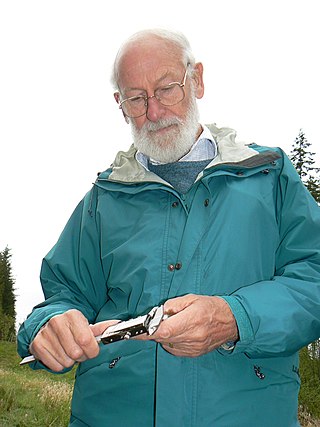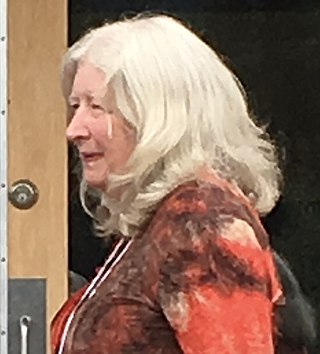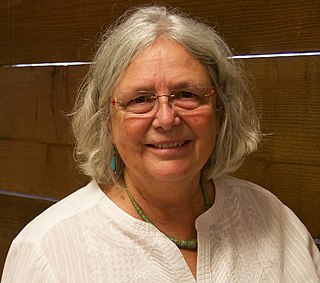Related Research Articles

Peter Raymond Grant and Barbara Rosemary Grant are a British married couple who are evolutionary biologists at Princeton University. Each currently holds the position of emeritus professor. They are known for their work with Darwin's finches on Daphne Major, one of the Galápagos Islands. Since 1973, the Grants have spent six months of every year capturing, tagging, and taking blood samples from finches on the island. They have worked to show that natural selection can be seen within a single lifetime, or even within a couple of years. Charles Darwin originally thought that natural selection was a long, drawn out process but the Grants have shown that these changes in populations can happen very quickly.

Restoration ecology is the scientific study supporting the practice of ecological restoration, which is the practice of renewing and restoring degraded, damaged, or destroyed ecosystems and habitats in the environment by active human interruption and action. Effective restoration requires an explicit goal or policy, preferably an unambiguous one that is articulated, accepted, and codified. Restoration goals reflect societal choices from among competing policy priorities, but extracting such goals is typically contentious and politically challenging.

Serpentine soil is an uncommon soil type produced by weathered ultramafic rock such as peridotite and its metamorphic derivatives such as serpentinite. More precisely, serpentine soil contains minerals of the serpentine subgroup, especially antigorite, lizardite, and chrysotile or white asbestos, all of which are commonly found in ultramafic rocks. The term "serpentine" is commonly used to refer to both the soil type and the mineral group which forms its parent materials.

In biogeography, a native species is indigenous to a given region or ecosystem if its presence in that region is the result of only local natural evolution during history. The term is equivalent to the concept of indigenous or autochthonous species. Every wild organism is known as an introduced species within the regions where it was anthropogenically introduced. If an introduced species causes substantial ecological, environmental, and/or economic damage, it may be regarded more specifically as an invasive species.

Robert Eric Ricklefs is an American ornithologist and ecologist. He was the Curators' Professor of Biology at the University of Missouri, St. Louis from 1996 until August 2019.
The term phylogenetic niche conservatism has seen increasing use in recent years in the scientific literature, though the exact definition has been a matter of some contention. Fundamentally, phylogenetic niche conservatism refers to the tendency of species to retain their ancestral traits. When defined as such, phylogenetic niche conservatism is therefore nearly synonymous with phylogenetic signal. The point of contention is whether or not "conservatism" refers simply to the tendency of species to resemble their ancestors, or implies that "closely related species are more similar than expected based on phylogenetic relationships". If the latter interpretation is employed, then phylogenetic niche conservatism can be seen as an extreme case of phylogenetic signal, and implies that the processes which prevent divergence are in operation in the lineage under consideration. Despite efforts by Jonathan Losos to end this habit, however, the former interpretation appears to frequently motivate scientific research. In this case, phylogenetic niche conservatism might best be considered a form of phylogenetic signal reserved for traits with broad-scale ecological ramifications. Thus, phylogenetic niche conservatism is usually invoked with regards to closely related species occurring in similar environments.
Johanna Schmitt is an evolutionary ecologist and plant geneticist. Her research is notable for its focus on the genetic basis of traits in ecologically valuable plants and on predicting how such plants will respond and adapt to environmental change such as climate warming. She has authored over 100 articles and her works have been cited over 7900 citations. She is honored with being the first female scientist at Brown University to be elected to the National Academy of Sciences.
Michael G. Barbour was a notable California botanist and ecologist. He was a Professor Emeritus at the University of California, Davis. His fields of expertise were in autecology and synecology of plants and vegetation in stressful environments, including marine strand, tidal salt marsh, vernal pools, warm desert scrub, mixed evergreen forest, oak forest, and montane conifer forest. This research was conducted in Alta and Baja California along the Pacific coast of North America, on the Gulf of Mexico coast, in northwestern Argentina, in southern Australia, in coastal and arid parts of Israel, in mountains of central-to-northern Spain, in mountains of the Canary Islands, and in mountains of Coast Range and Sierra Nevada of California.

Diana Harrison Wall is the Founding Director of the School of Global Environmental Sustainability, a Distinguished Biology Professor, and Senior Research Scientist at the Natural Resource Ecology Laboratory at Colorado State University. She is an environmental scientist and a soil ecologist and her research has focussed on the Antarctic McMurdo Dry Valleys. Wall investigates ecosystem processes, soil biodiversity and ecosystem services and she is interested in how these are impacted by global change. The Wall Valley was named after her in recognition of her research in the McMurdo Dry Valleys. Wall is a globally recognised leader and speaker on life in Antarctica and climate change.
Ruth Geyer Shaw is a professor and principal investigator in the Department of Ecology, Evolution and Behavior at the University of Minnesota. She studies the processes involved in genetic variation, specializing in plant population biology and evolutionary quantitative genetics. Her work is particularly relevant in studying the effects of stressors such as climate instability and population fragmentation on evolutionary change in populations. She has developed and applied new statistical methods for her field and is considered a leading population geneticist.
Allison K. Shaw is an American ecologist and professor at the University of Minnesota. She studies the factors that drive the movements of organisms.

Carol Linda Boggs is an American biologist specializing in the reproductive biology, population biology, ecology, and evolution of butterflies. Boggs completed her BA in 1973 and her PhD in 1979 in zoology at the University of Texas at Austin. Since 2013, she has been a professor in the School of the Earth, Ocean and Environment and the Department of Biological Sciences at the University of South Carolina. Boggs is the author of more than 120 peer-reviewed articles and has served on editorial boards for several journals. She has been a fellow of the American Association for the Advancement of Science since 2001.
Sharon Y. Strauss is an American evolutionary ecologist. She is a Professor of Evolution and Ecology at the University of California, Davis.
Stephanie M. Carlson is the A.S. Leopold Chair in Wildlife Biology at the University of California Berkeley. Her research considers fish ecology, freshwater ecology, and evolutionary ecology.
Jennifer B. H. Martiny is an American ecologist who is a professor at the University of California, Irvine. Her research considers microbial diversity in marine and terrestrial ecosystems. In 2020 she was elected a Fellow of the American Association for the Advancement of Science.

Susan Ustin is an American earth scientist who is the Distinguished Professor of Environmental Resource Science at the John Muir Institute for the Environment, University of California, Davis. Her research makes use of remote sensing technology to understand the characteristics of plant communities.
Priyanga Amarasekare is a Professor of Ecology and Evolutionary Biology at the University of California, Los Angeles (UCLA) and distinguished Fellow of the Ecological Society of America (ESA). Her research is in the fields of mathematical biology and trophic ecology, with a focus on understanding patterns of biodiversity, species dispersal and the impacts of climate change. She received a 2021 Guggenheim Fellowship and received ESA's Robert H. MacArthur Award in 2022.
Aimée Classen is an American ecologist who studies the impact of global changes on a diverse array of terrestrial ecosystems. Her work is notable for its span across ecological scales and concepts, and the diversity of terrestrial ecosystems that it encompasses, including forests, meadows, bogs, and tropics in temperate and boreal climates.
Adina Merenlender is a Professor of Cooperative Extension in Conservation Science at University of California, Berkeley in the Environmental Science, Policy, and Management Department, and is an internationally recognized conservation biologist known for land-use planning, watershed science, landscape connectivity, and naturalist and stewardship training.
Jordi Bascompte is a professor of ecology at the University of Zurich and the director of its specialized master's program on quantitative environmental sciences. He is best known for having brought the interactions of mutual benefit between plants and animals into community ecology, at the time largely dominated by predation and competition. His application of network theory to the study of mutualism has identified general laws that determine the way in which species interactions shape biodiversity.
References
- 1 2 Susan Harrison publications indexed by Google Scholar
- 1 2 3 4 5 6 7 8 9 10 "Susan Harrison". www.nasonline.org. Retrieved 2019-05-01.
- 1 2 "NRS researcher Susan Harrison elected to National Academy of Sciences". UCNRS. 2018-05-11. Retrieved 2019-05-01.
- ↑ "Susan Harrison | College of Biological Sciences". biology.ucdavis.edu. Retrieved 2019-05-01.
- 1 2 "Inter Research » Ecology Institute » IRPE Prize". www.int-res.com. Retrieved 2019-05-01.
- ↑ "Terrestrial Ecology Tree - Susan P. Harrison Family Tree". academictree.org. Retrieved 2019-05-01.
- ↑ Harrison, Susan; Murphy, Dennis D.; Ehrlich, Paul R. (1988). "Distribution of the Bay Checkerspot Butterfly, Euphydryas editha bayensis: Evidence for a Metapopulation Model". The American Naturalist. 132 (3): 360–382. doi:10.1086/284858. ISSN 0003-0147. JSTOR 2461988. S2CID 55140501.
- ↑ Harrison, Susan (1989). "Long-Distance Dispersal and Colonization in the Bay Checkerspot Butterfly, Euphydryas Editha Bayensis". Ecology. 70 (5): 1236–1243. doi:10.2307/1938181. ISSN 1939-9170. JSTOR 1938181.
- ↑ Harrison, Susan (1990-11-08). "Ecological discontinuity". Nature. 348 (6297): 123–124. Bibcode:1990Natur.348..123H. doi: 10.1038/348123a0 . ISSN 1476-4687. S2CID 4309255.
- ↑ "Wisconsin Ecology". ecology.wisc.edu. Retrieved 2019-05-01.
- ↑ Harrison, Susan (1991-01-01). "Local extinction in a metapopulation context: an empirical evaluation". Biological Journal of the Linnean Society. 42 (1–2): 73–88. doi:10.1111/j.1095-8312.1991.tb00552.x. ISSN 0024-4066.
- ↑ Harris-Lovett, Sasha (2015-06-24). "Scientists see climate change in action in California wildflower fields". Los Angeles Times. Archived from the original on May 2, 2019. Retrieved May 2, 2019.
- ↑ "Native wildflowers bank on seeds underground to endure drought: Exotic grasses depleted seed bank accounts during drought while natives saved". ScienceDaily. Retrieved 2019-05-01.
- ↑ Kerlin, Kat. "Native Wildflowers Bank on Seeds Underground to Endure Drought". biology.ucdavis.edu. Retrieved 2019-05-01.
- 1 2 Kerlin, Kat. "Burning Questions: Wildfires at Two UC Davis Natural Reserves Spark Scientific Exploration". biology.ucdavis.edu. Retrieved 2019-05-01.
- ↑ Serpentine.
- ↑ "Brian Anacker". Ecology and Evolutionary Biology. 2015-11-03. Retrieved 2019-05-01.
- 1 2 "Ecologist Susan Harrison Elected to National Academy". UC Davis. 2018-05-08. Retrieved 2019-05-01.
- ↑ "Siskiyou Field Institute - 2014 Instructors". www.thesfi.org. Retrieved 2019-05-01.
- ↑ "Editorial board | Proceedings of the Royal Society B: Biological Sciences". royalsocietypublishing.org. Retrieved 2019-05-01.
- ↑ "Dr. Susan Harrison". John Muir Institute of the Environment. Retrieved 2019-05-01.
- ↑ Bronstein, Judith L. (2004). "Secretary's Report, 2004: American Society of Naturalists". The American Naturalist. 164 (6): 824–827. doi:10.1086/426483. ISSN 0003-0147. JSTOR 10.1086/426483. S2CID 82185532.
- ↑ "ESA Fellows – Ecological Society of America" . Retrieved 2019-05-01.